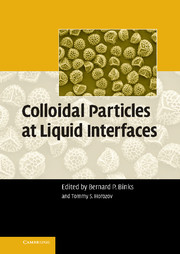Book contents
- Frontmatter
- Contents
- Preface
- List of Contributors
- 1 Colloidal Particles at Liquid Interfaces: An Introduction
- Section 1 Particles at Planar Liquid Interfaces
- Section 2 Particles at Curved Liquid Interfaces
- 5 Particle-Laden Interfaces: Rheology, Coalescence, Adhesion and Buckling
- 6 Solids-Stabilized Emulsions: A Review
- 7 Novel Materials Derived from Particles Assembled on Liquid Surfaces
- 8 Interfacial Particles in Food Emulsions and Foams
- 9 Collection and Attachment of Particles by Air Bubbles in Froth Flotation
- 10 Antifoam Effects of Solid Particles, Oil Drops and Oil—Solid Compounds in Aqueous Foams
- 11 Metal Foams: Towards High-Temperature Colloid Chemistry
- Index
7 - Novel Materials Derived from Particles Assembled on Liquid Surfaces
Published online by Cambridge University Press: 11 October 2009
- Frontmatter
- Contents
- Preface
- List of Contributors
- 1 Colloidal Particles at Liquid Interfaces: An Introduction
- Section 1 Particles at Planar Liquid Interfaces
- Section 2 Particles at Curved Liquid Interfaces
- 5 Particle-Laden Interfaces: Rheology, Coalescence, Adhesion and Buckling
- 6 Solids-Stabilized Emulsions: A Review
- 7 Novel Materials Derived from Particles Assembled on Liquid Surfaces
- 8 Interfacial Particles in Food Emulsions and Foams
- 9 Collection and Attachment of Particles by Air Bubbles in Froth Flotation
- 10 Antifoam Effects of Solid Particles, Oil Drops and Oil—Solid Compounds in Aqueous Foams
- 11 Metal Foams: Towards High-Temperature Colloid Chemistry
- Index
Summary
Introduction
Functional materials
The research in novel nano- and microstructured materials with custom designed properties, composition and structure (symmetry) has been driven by the potential of using such materials in forthcoming advanced technologies. There is specific strong interest in complex one dimensional (1-D) and periodic two dimensional (2-D) and three dimensional (3-D) structures from colloidal particles. Complex 1-D assemblies have been considered as novel building blocks for materials with advanced hierarchical structure. Periodic 2-D and 3-D structures from colloidal particles display several unique and potentially usable properties resulting from the existence of a long-range order. The formation of such materials is dependent on the interactions of particles with liquid—solid or liquid—liquid interfaces and/or their confinement in thin liquid films. The need to understand the forces involved in the assembly of structures from colloidal particles has led to important fundamental insights in the field of colloidal forces and self-organization.
The materials formed by organization and assembly of colloidal particles have a number of unique and potentially utilizable features. Coatings and surface patterning with colloidal particles allow for modification of properties like wetting and reflectivity. The long-range organization of particles in coatings brings a number of significant advantages. Particle arrays often display strong interaction with light and other electromagnetic radiation.
- Type
- Chapter
- Information
- Colloidal Particles at Liquid Interfaces , pp. 225 - 297Publisher: Cambridge University PressPrint publication year: 2006
- 8
- Cited by

